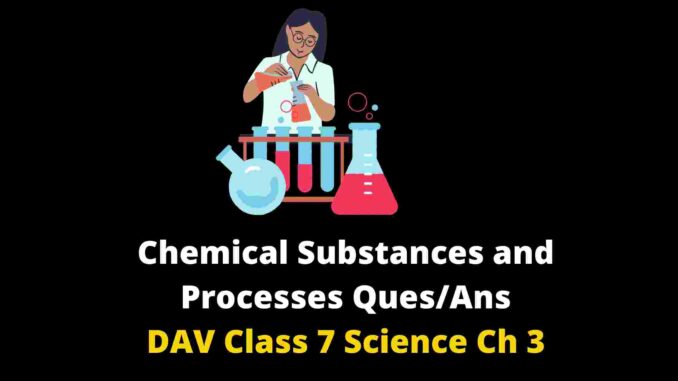
Chemical Substances and Processes is a chapter in DAV Class 7 Science textbook. This chapter talks about physical and chemical changes, their characteristics. Discussion of elements, compounds and mixture. In this article, we have given Chemical substances and processes solutions or you can say DAV Class 7 Science Chapter 3 solutions. We have also given explanations and suitable examples wherever required.
Chemical Substances and Processes Solutions DAV
A. Fill in the blanks
1. Materials made up of same kind of particles are called ___________.
2. The type and number of particles of each kind present in a substance is given by its ___________.
3. The chemical formula of water is ___________.
4. Iron gets rusted on coming in contact with ___________ and ___________.
5. The process that leads to a chemical change is called a ___________.
6. In a neutralisation reaction, ___________ and ___________ are formed.
Ans.
1) Pure substances
2) Chemical formula
3) H2O
4) water and air
5) Chemical Reaction
6) Salts and Water
B. Write True or False for the following statements.
1. All matter is made up of atoms.
2. Compounds are substances consisting of two or more elements chemically combined in a fixed ratio.
3. The symbol of element copper is Cu.
4. Formula of sodium chloride is written as ClNa.
5. The chemical formula of aluminium sulphate is Al2SO4.
6. New substance formed in a chemical reaction is called product.
7. Magnesium hydroxide is an acid.
Ans:
(1) True
(2) True
(3) True
(4) False
(5) False
(6) True
(7) False
Also see: Reproduction in Plants Solutions DAV Class 7 Science
C. Tick the correct option.
Answer:
1. silver
2. one atom of hydrogen, one atom of nitrogen, and three atoms of oxygen.
3. Mg3(PO4)2
4. displacement reaction
5. CaO
D. Answer the following questions in brief.
1. What are elements?
Answer: Elements are substances that comprise atoms of the same kind. Ex. Nitrogen and Iron
2. Give the chemical symbol of iron and chlorine.
Answer:
Iron: Fe
chlorine: Cl
3. Write the chemical formulae of the following compounds:
(a) Aluminium oxide (b) Zinc acetate
Ans:
a) Al2O3
b) (CH3COO)2Zn
4. Balance the following equation:
Ca(OH)2 + HCl → CaCl2 + H2O
Balanced Equation:
Ca(OH)2 + 2HCl → CaCl2 + 2H2O
5. What does a chemical equation represent?
A chemical reaction represents the reactants that are present on the left-hand side and the products formed after the chemical reaction. The products are present on the right-hand side. It shows the substances with their chemical formulae.
6. What are reactants and products in a chemical equation?
Reactants in a chemical equation are the substances that reacted with each other and products are substances formed after the reaction. Products are written on the right-hand side, reactants are written on the left-hand side.
Don’t miss: Light Question Answers DAV Class 7 Science
7. Give one example of a combination reaction.
A combination reaction is the reaction of two reactants to form a single product.
2Mg + O2 –> 2MgO
Chemical Substances and Processes DAV Class 7
E. Answer the following questions.
1. Write the steps involved in writing the chemical formula of calcium phosphate.
Answer:
To write the formula of calcium phosphate, we first write the symbols for calcium and phosphate ions with their charges.
Ca²+ (calcium), (PO4)³– (phosphate)
Then we follow the criss-cross method to write down the formula of Calcium Phosphate:
Ca2+ x (PO4)3- –> Ca3(PO4)2
You will learn more about chemical formula formation through the criss-cross method in Class 9.
2. How is a chemical change different from a physical change?
In physical changes new substances are not formed wherease in a chemical reaction new substances are formed after the reaction. The new substances may have different properties than the reacting substances
Physical reaction: Melting of ice
Chemical reaction: Rust formation on iron substances
3. Neutralisation reaction is a chemical change. Justify this statement with the help of an example.
Neutraliation reaction is a reaction in which an acid and base reacts with each other to form a salt and water. The salt form has different properties from both acid and base
Ex.
NaOH (sodium hydroxide) + HCl (hydrochloric acid) –> NaCl ( Sodium chloride) + H2O (water)
5. Classify the following reactions into different types, giving reason.
a) CaO(s) + SiO2(g) –> CaSiO3
(b) KOH(aq) + HCl(aq) –> KCl(aq) + H2O(l)
(c) Cu(s) + 2AgNO3(aq) –> Cu(NO3)2(aq) + 2Ag(s)
(d) BaCO3(s) –> (heat) (s) BaO(s) + CO2(g)
Answer:
(a) This is a combination reaction because 2 reactants are reacting with each other to form a new compound.
(b) This will be called a Neutralization reaction because a base (KOH) reacts with an acid (HCl) to form a salt (KCl) and water (H2O).
(c) Displacement reaction because Cu (copper) displaces Ag (silver) as it is more reactive in nature.
(d) This is an example of decomposition reaction because barium carbonate (BaCO3) decomposes to give barium oxide (BaO) and carbon dioxide (CO2).
- DAV Class 7 Science Solutions With Explanations: All Chapters - February 6, 2022
- Pollution of Water Question Answers | DAV Class 8 Science - February 4, 2022
- Fabric from Fibre Solutions | DAV Class7 Science Chapter 14 - January 25, 2022

Leave a Reply